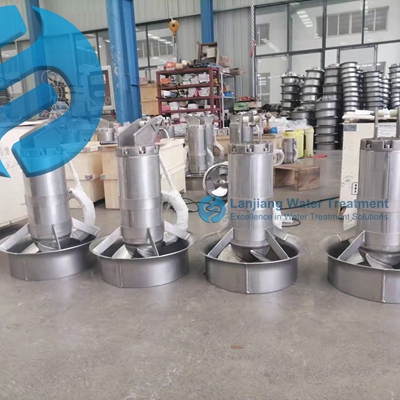Sewage mixer (mixer) plays a crucial role in the sewage treatment system, and its working principle mainly involves the following aspects:

First, liquid flow and mixing
Rotary motion: The sewage mixer rotates in the sewage through the motor to drive the mixing shaft and the mixing blade. This rotational motion can cause the liquid to flow, forming vortexes and turbulence, thereby breaking the laminar state of the liquid and achieving more efficient mixing.
Special blade design: Mixers are often equipped with specially designed blades that effectively throw liquid around the blender to create a larger mixing area. This design helps to mix the various components of the sewage, both solid and liquid, together evenly.
Second, suspension of suspended substances
Prevent deposition: The movement of the mixer not only promotes the flow and mixing of the liquid, but also helps stir solid suspended substances (such as sludge particles, impurities, etc.) into the liquid to prevent it from settling on the bottom of the pool. This is essential to maintain uniform distribution and treatment efficiency in wastewater.
Increased contact area: By suspending the solid material, the mixer increases the contact area between the solid and the liquid, which facilitates subsequent chemical reactions or biodegradation processes.
Third, oxygen delivery
Improve dissolved oxygen: In the biological treatment process, the mixing effect of the mixer also helps to increase the transfer and dissolution of oxygen in the water. This is essential to sustain the biological oxidation reaction in the sewage treatment process, as many microorganisms require oxygen to decompose organic matter.
Promote biodegradation: By increasing the dissolved oxygen content, the mixer promotes microbial activity and accelerates the biodegradation process of organic matter.
Fourth, uniform distribution
Parameter uniformity: The movement of the mixer helps to ensure a uniform distribution of temperature, pH and other key parameters throughout the treatment tank. This is of great significance to improve the consistency and stability of the processing process.
Improve treatment efficiency: By maintaining the uniformity of parameters, the mixer helps to improve the overall treatment efficiency of the sewage treatment system and reduce treatment costs.
Fifth, other characteristics
High efficiency: The sewage mixer can quickly suspend the sludge and promote the degradation and removal of microorganisms, thereby improving the treatment efficiency of the sewage treatment system.
Energy saving and environmental protection: The electric motor driven mixer consumes less energy than other traditional mixing methods, and reduces environmental pollution.
Simple structure: The structure of the mixer is relatively simple, easy to install and maintain, and reduces operating costs.
Strong adaptability: The sewage mixer is suitable for a variety of different types of sewage treatment systems, including domestic sewage, industrial sewage, hospital sewage, etc.
To sum up, the sewage mixer plays an irreplaceable role in the sewage treatment process through its unique mixing principle and working mechanism. By promoting the flow and mixing of liquids, the suspension of suspended solid substances, the transfer of oxygen and the uniform distribution of parameters, the sewage mixer significantly improves the treatment efficiency and stability of the sewage treatment system.
Nanjing LanJiang Water Treatment Equipment Co.,Ltd manufactures equipment for wastewater treatment. We were established in 2001. Since then, we designed and produced submersible mixers, top entry mixers, aerators and other wastewater treatment equipment.
Post time:2024-07-31